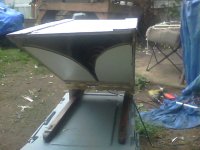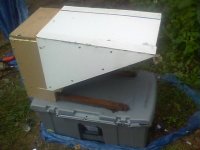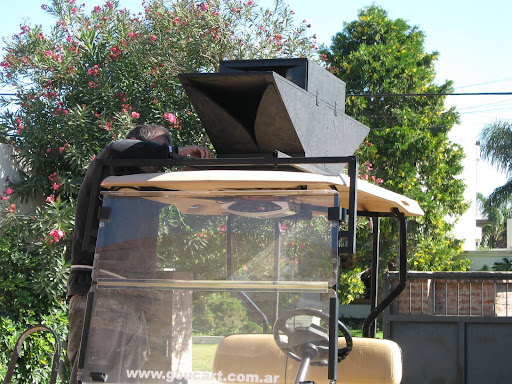Drivers are the woofers from a JVC AX-R97 based system from 1989. Pretty awesome commercial 3ways for their time. The xovers were mid/high pass, so I had to estimate their power handling at the 125 wRMS/ch of the amp.
The drivers were sealed clamshell isobaric and a minimal Karlson Klam12 style cab/vent built around them.
1 kHz/1m/1w test = 101 dB, dropping to ambient 70 dB background at 45 degrees L/R.
Chest pounding punch? No, but clear bass string impact/note at 50 m across a grass grown pasture. Where there's call for a focused low freq window at a distance, this might well do.


The drivers were sealed clamshell isobaric and a minimal Karlson Klam12 style cab/vent built around them.
1 kHz/1m/1w test = 101 dB, dropping to ambient 70 dB background at 45 degrees L/R.
Chest pounding punch? No, but clear bass string impact/note at 50 m across a grass grown pasture. Where there's call for a focused low freq window at a distance, this might well do.


Cool -- the recent klam12 built by thejessman and loaded with Eminence C12cx is pretty good too - better than some of my FR - - this size seems better than a klam8 - - not had it outdoors but should be good at 50M - so far, klam12 and 15 have been pretty good- also my klam18 but its too bulky to get up on a cheap tripod - - when not using a coax, an extended K-tube and compression driver should work well for treble- -- a coax can also feed a K-tube
by using a K-tube extended from a coax, the highs for the most part are removed from influence of the front chamber -it can also sound good with just a coaxial or fullrange
here's a mobile double klam

An externally hosted image should be here but it was not working when we last tested it.
by using a K-tube extended from a coax, the highs for the most part are removed from influence of the front chamber -it can also sound good with just a coaxial or fullrange
An externally hosted image should be here but it was not working when we last tested it.
here's a mobile double klam
Last edited:
drmcclainphd --- what are the dimensions of your klam's coupler portion ? have you had any luck with mini-klams? I think the recent klam12 made for me would do pretty well with a Beta12lta - but its loaded with a stiff suspension edge wound 2.5" coil Eminence coax rated ~99dB and maybe loaded with a Selenium compression driver (or PRV) -can't remember - do you think we could get 100M throw? it would probably irk the neighbors if I tried that much spl...
since this post was moved to the subwoofer forum, here's one of Wayne Neuser's klam-subs from over 20 years ago -its duty was to augment those 8-10" Scan Speak woofers in the other four cabinets. From what I understand it had a passive radiator and perhaps a 10" woofer - I think from a description one fired upwards into a slot - no details were given so one would have to work out how to make one from this picture -- just looking at it, I would say there's a driver or PR firing at the floor
since this post was moved to the subwoofer forum, here's one of Wayne Neuser's klam-subs from over 20 years ago -its duty was to augment those 8-10" Scan Speak woofers in the other four cabinets. From what I understand it had a passive radiator and perhaps a 10" woofer - I think from a description one fired upwards into a slot - no details were given so one would have to work out how to make one from this picture -- just looking at it, I would say there's a driver or PR firing at the floor
An externally hosted image should be here but it was not working when we last tested it.
Last edited:
1 kHz/1m/1w test = 101 dB, dropping to ambient 70 dB background at 45 degrees L/R.
Chest pounding punch? No, but clear bass string impact/note at 50 m across a grass grown pasture. Where there's call for a focused low freq window at a distance, this might well do.
[
I'd have trouble seeing a loudspeaker 155 feet away let alone hear a double bass plunked at that distance in an open field. Do you mean feet rather than meters or am I confused about the inverse-square law?
Ben
Last edited:
Ben,I'd have trouble seeing a loudspeaker 155 feet away let alone hear a double bass plunked at that distance in an open field. Do you mean feet rather than meters or am I confused about the inverse-square law?
Ben
With the usual inverse distance loss of 6 dB per doubling of distance, a single typical front loaded 15" capable of around 120 dB at one meter will still produce over 98 dB at 50 meters, well above the ambient noise of 70 dB.
Art
Ben,
With the usual inverse distance loss of 6 dB per doubling of distance, a single typical front loaded 15" capable of around 120 dB at one meter will still produce over 98 dB at 50 meters, well above the ambient noise of 70 dB.
Art
Assuming a loud 120dB at 1 meter, I seem to get something more like 86dB (less a bunch of additional losses along the way on the ground), which is not a lot oomph at double-bass frequencies.
5 and a bit doublings?
Ben
Last edited:
here's Lars Moseholm's spl plots out to 25M for a little klam with 8" speaker which was marketed by an Alan Weiss some years back - I don't remember if his report on Job Ulfman's Karlson forum had details for conditions or not.
this little klam has a lot of 'sea shell' artifacts which are obnoxious up close - but sounded pretty clear 30 to 150 feet away
here's a close copy of the Weiss "Rocket"
here's a sound clip of my klam15 loaded with an old Eminence cast frame C15cx, generic Eminence network (might be the 3k5?) and probably a Selenium 210ti - for this clip I crammed a piece of 1" pipe down the coax throat and taped on a 5.5" long K-tube
I'd almost swear 40 yrs ago seeing a K-variant which wasn't klam nor regular K in an outdoor pa
https://www.youtube.com/watch?v=mupb8X6iZ6I&feature=youtu.be
this little klam has a lot of 'sea shell' artifacts which are obnoxious up close - but sounded pretty clear 30 to 150 feet away
here's a close copy of the Weiss "Rocket"
An externally hosted image should be here but it was not working when we last tested it.
An externally hosted image should be here but it was not working when we last tested it.
here's a sound clip of my klam15 loaded with an old Eminence cast frame C15cx, generic Eminence network (might be the 3k5?) and probably a Selenium 210ti - for this clip I crammed a piece of 1" pipe down the coax throat and taped on a 5.5" long K-tube
I'd almost swear 40 yrs ago seeing a K-variant which wasn't klam nor regular K in an outdoor pa
https://www.youtube.com/watch?v=mupb8X6iZ6I&feature=youtu.be
An externally hosted image should be here but it was not working when we last tested it.
Last edited:
A mix of quantitative and qualitative statements.
Yes, from a great distance away you can hear a double-bass playing. Your hearing mechanism can even "hear" the low notes because that is a skill the brain has... to recreate the fundamentals. That is well known by many on this forum. Sounds pretty good to non-hobbyists.
But if the amp removed all the sounds over say, 100 Hz, likely you'd hear nothing much that thumped like a double-bass when listening from a distance.
Ben
Yes, from a great distance away you can hear a double-bass playing. Your hearing mechanism can even "hear" the low notes because that is a skill the brain has... to recreate the fundamentals. That is well known by many on this forum. Sounds pretty good to non-hobbyists.
But if the amp removed all the sounds over say, 100 Hz, likely you'd hear nothing much that thumped like a double-bass when listening from a distance.
Ben
Assuming a loud 120dB at 1 meter, I seem to get something more like 86dB (less a bunch of additional losses along the way on the ground), which is not a lot oomph at double-bass frequencies.
5 and a bit doublings?
Ben
Both of you are wrong, LOL.
6dB per doubling of distance is based on free-field spherical sound divergence, which implies no nearby objects or surfaces at all.
For a bass speaker sitting on the ground, the divergence is not spherical at bass frequencies. It's more hemispherical than spherical (hell, most of our sims are done in 2PI to reflect that
Getting better.Both of you are wrong, LOL.
6dB per doubling of distance is based on free-field spherical sound divergence, which implies no nearby objects or surfaces at all.
For a bass speaker sitting on the ground, the divergence is not spherical at bass frequencies. It's more hemispherical than spherical (hell, most of our sims are done in 2PI to reflect that). Divergence is more likely to measure closer to 4dB than 6dB - see Alton Everest's Master Handbook of Acoustics for more information on the subject.
My impression from some field work projects I've been involved in over the years is that those kinds of estimates are not too accurate when you go out into the real world.
And what is the Sabine coefficient for a grass field and how does that affect things?
http://www.greenroofresearch.co.uk/acoustic/EuroRegio-262.pdf
If in the vicinity of .5 (just a guess based on the link above and on architectural materials).... sure hard for sound to propagate very far.
Ben
Last edited:
I'm pretty sure Jess Oliver's Magna-Clam was the same as Karlson's AP100 - both would have had lossy venting between the rear and front chamber, Altec 421 and a K-tube driven by an University Sound compression driver -- it may have been what was installed at Radio City Music Hall by Karlson and Weiss - ? (there were plans of a 12 foot long klam ! AP100 and Magna-Clam were ~45" long) I'd like to find a better scan of this ad. -- am not sure but perhaps the lower lip on these and the Phase III allowed two klams to be locked together - -- Magna-Clam looked cool enough


Last edited:
I'm pretty sure Jess Oliver's Magna-Clam was the same as Karlson's AP100 - both would have had lossy venting between the rear and front chamber, Altec 421 and a K-tube driven by an University Sound compression driver -- it may have been what was installed at Radio City Music Hall - ? I'd like to find a better scan of this ad

the rehashing of Karlson's "APX" for Jess as the Oliver Sound Phase III


the rehashing of Karlson's "APX" for Jess as the Oliver Sound Phase III

From what I've read, it seems that the relative closeness and size of the radiator (woofer) makes it likely to have slower dropoff in the near field since it is not yet a point source, which can affect the inverse square calculation even in 4pi. There's a good measurement graph I've seen somewhere that demonstrates the idea pretty clearly but I'll be damned if I know where it is.
I'm just making up numbers here, but for example, a source that produces 120db at 1 m may have a near field response which does not drop as fast as inverse square would predict and produces 116db at 3m. Calculating inverse square from that point you'd end up getting about 93db at 50m from that figure.
If Brian is right as 5db/doubling is a more realistic figure for this particular radiation situation, then you're up to 97db at 120m.
I'm just making up numbers here, but for example, a source that produces 120db at 1 m may have a near field response which does not drop as fast as inverse square would predict and produces 116db at 3m. Calculating inverse square from that point you'd end up getting about 93db at 50m from that figure.
If Brian is right as 5db/doubling is a more realistic figure for this particular radiation situation, then you're up to 97db at 120m.
Last edited:
And what is the Sabine coefficient for a grass field and how does that affect things?
Likely little or no effect at bass frequencies (<100 Hz).
Subwoofers? They moved it to subs? That's just wrong. These were not sub drivers and the system is not meant to be. In keeping with things Klamish, this was meant to be as full range as possible.
freddyiyiyi, the baffle is 13" square, the rear section is 5.5", well sealed and stuffed enough to dampen box resonances. Seems a mite tight, I know, but an isobaric can get away with down to half the single driver sealed volume. The vent overhang is 19" from the front of the baffle. Surely better drivers should get a good tight sound farther. These were 1989 vintage, still original foam surrounds. I've had some excellent luck with 8" klams with GRS BOFU clones in them. I've had people walk over from a block away while I was testing them, doing so because the clarity carried so well.
As for the rest of it all, folks, it is trivial to violate rules based on generalizations developed from perfect objects in ideal environments, because reality is all complex dynamics from imperfect special cases. Doing so is one of my greatest joys, and if it bursts bubbles, so much the better. This is why I became a scientist, specifically an experimentalist. Some make a hobby out of accumulating theoretical concepts and sticking variables into them. I saw wood, solder wires and measure what comes out. If I say something is a certain number, it's because I measured it. If you think it's wrong, cut wood, solder wires, and measure what you get, and see if it's different. Same or not, this way we will learn something more than technological mantras. OOoooooohhhhhmmmm.
freddyiyiyi, the baffle is 13" square, the rear section is 5.5", well sealed and stuffed enough to dampen box resonances. Seems a mite tight, I know, but an isobaric can get away with down to half the single driver sealed volume. The vent overhang is 19" from the front of the baffle. Surely better drivers should get a good tight sound farther. These were 1989 vintage, still original foam surrounds. I've had some excellent luck with 8" klams with GRS BOFU clones in them. I've had people walk over from a block away while I was testing them, doing so because the clarity carried so well.
As for the rest of it all, folks, it is trivial to violate rules based on generalizations developed from perfect objects in ideal environments, because reality is all complex dynamics from imperfect special cases. Doing so is one of my greatest joys, and if it bursts bubbles, so much the better. This is why I became a scientist, specifically an experimentalist. Some make a hobby out of accumulating theoretical concepts and sticking variables into them. I saw wood, solder wires and measure what comes out. If I say something is a certain number, it's because I measured it. If you think it's wrong, cut wood, solder wires, and measure what you get, and see if it's different. Same or not, this way we will learn something more than technological mantras. OOoooooohhhhhmmmm.
Subwoofers? They moved it to subs? That's just wrong. These were not sub drivers and the system is not meant to be. In keeping with things Klamish, this was meant to be as full range as possible.
freddyiyiyi, the baffle is 13" square, the rear section is 5.5", well sealed and stuffed enough to dampen box resonances. Seems a mite tight, I know, but an isobaric can get away with down to half the single driver sealed volume. The vent overhang is 19" from the front of the baffle. Surely better drivers should get a good tight sound farther. These were 1989 vintage, still original foam surrounds. I've had some excellent luck with 8" klams with GRS BOFU clones in them. I've had people walk over from a block away while I was testing them, doing so because the clarity carried so well.
As for the rest of it all, folks, it is trivial to violate rules based on generalizations developed from perfect objects in ideal environments, because reality is all complex dynamics from imperfect special cases. Doing so is one of my greatest joys, and if it bursts bubbles, so much the better. This is why I became a scientist, specifically an experimentalist. Some make a hobby out of accumulating theoretical concepts and sticking variables into them. I saw wood, solder wires and measure what comes out. If I say something is a certain number, it's because I measured it. If you think it's wrong, cut wood, solder wires, and measure what you get, and see if it's different. Same or not, this way we will learn something more than technological mantras. OOoooooohhhhhmmmm.
I think it would be quite informative to take measurements at various frequencies and distances to reference. Unfortunately I don't have the space.
- Status
- This old topic is closed. If you want to reopen this topic, contact a moderator using the "Report Post" button.
- Home
- Loudspeakers
- Subwoofers
- The Woof Woof Klam